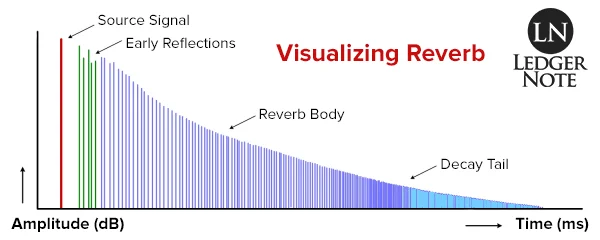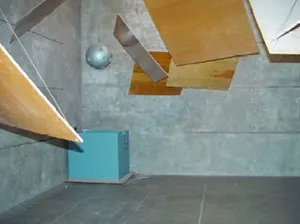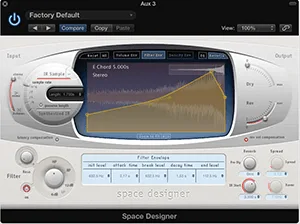
I do agree there’s only three main categories, but anyone looking to fully explain the topic can’t limit the discussion to five or seven types of reverb, which is what always happens. It’s unfair to the reader.
If you’re reading this then you probably already understand what this effect is and how it arises in nature or is created acoustically, mechanically, through electronics, or through digital algorithms. If you want to the background story, check out our article What is Reverb?
I also want to mention that, while I’ll be discussing each type, its characteristics, and when to use them that I won’t be going in-depth on how to use them. We’ve covered that before in our article Mixing with Reverb, and if you’re here as a mixer you should definitely open that up to read next. Let’s get to it.

We’ll follow the convention of separating these into three main groups, which are acoustic, mechanical, and digital. It’s a good mental schema to remember based on how they’re created (or were originally created, since we’re all mainly using digital reverbs now). I’ll explain each category as we go.
Acoustic Reverbs

Acoustic reverbs refer to chamber reverberators, which is a fancy way of saying “rooms of various size.” We discovered that the size, shape, and material of the walls all affected the characteristics of the reverb. Some studios in the old days even went as far as to create their own reverb rooms.
Room
When we say room, we’re referring to small rooms the size of a bedroom or living room. They’re used to create the intimate and typical sound we’re used to hearing throughout our time spent indoors. They have a short decay tail (0.75 seconds or so) and are more heavy on the early reflections.
Room verbs feature a thick density of echoes that add coloration and warmth to a track, like a real small room would do. You’ll notice a build up of low and low-middle frequencies, which will require some equalization if you use a lot of room reverb. It’s great for drums and stringed instruments at higher levels, and at lower levels on the more prominent instruments in a mix.
Chamber
Chamber verbs refer to the chamber reverberation created in studios with the budget and space to build their own rooms for this purpose. You can compare them to room reverb but with less build up of coloration to help maintain transparency. They also focus more on the thickness of the tail while keeping the early reflections thinner.
These were designed to be transparent and you can think of them as a more neutral option. They take less post-processing work to deal with but impart less of their own characteristics. It’s useful to use on vocals, lead guitar, and any of the more prominent tracks in a mix.
Hall
Hall is the shorter way of saying ‘concert hall,’ which are big spaces designed to have a pleasing acoustic environment. The decay tails are longer in the 2 second range and have a bit of a pre-delay bulit in so that the early reflections don’t begin immediately. The density swells in the tail as opposed to building up in the early energy.
You typically hear these on the type of mixes you’d expect, for orchestras, solo piano, or singer-songwriter types of songs. Mix engineers have taken to using them on slower songs like ballads and anything else with a more sparse arrangement.
Cathedral
You can think of a cathedral reverb as a longer, more wet hall verb. This is based less on the size of a cathedral versus a concert hall and more of the highly reflective, less scattering material used when building them, and their typically more square or rectangular shapes. This leads to their longer decay times (as high as 10 seconds).
They are very light on the early reflections and energy and more in the build up, leading to a thick smearing or blurring of sounds. Avoid in on high tempo songs with fast, rhythmic elements and use it more on slow, melodic tracks. The name is fitting, so try to stay in that wheel house. If you see mention of cave or stadium reverbs, they’re like cathedral ones but with more of a slapback delay added.
Ambience
This type of reverb has a very short decay tail (almost non-existent around 0.5 seconds). It’s mostly comprised of early reflections that very faithful to the original sound. It adds very little character or color, being as dry as possible. It smooths out the audio and is over so quickly many listeners won’t notice it’s there.
Ambience reverb is typically used on a bus to push entire groups of tracks or the whole song through it. This provides a sense of glue, meaning that it subtly makes all of the instrumentation sound like it actually belongs together and was recorded in the same acoustic environment.
Mechanical Reverbs

Mechanical reverbs refer to the two types we invented that let us create the effect without needing an entire room to do it. It allowed us to tweak the characteristics to a degree. They eventually became smaller and cheaper over time, though the first ones to hit the market weighed up to 600 pounds (like the Abbey Road Studios’ EMT 140.
Plate
Plate reverbs are created by vibrating a metal sheet like you would a speaker cone and recording the result. They can have short, medium, or long decay times but almost always have a very fast attack in terms of the early reflections which are high in energy.
They’re dark but the initial energy can be fairly bright. When I think of plate verbs I always think about the most popular Pink Floyd albums. They have an eerie, dark atmosphere to them even though some of the songs are melodically beautiful and uplifting. This is because they recorded with that big 600 lb. plate at Abbey Roads.
Spring
Spring reverbs are created by vibrating a spring just like a plate. They have a short to medium length decay, are fairly dark, and have a metallic character to them. Physical springs can be found in guitar amplifiers still, though it’s becoming more rare.
Mechanical springs had problems associated with their movement, and even though digital springs lack those problems, they still go largely unused, because they aren’t that pleasing, to be honest. The problem is if they’re bumped they emit an atrocious thundering sound (and they don’t sound that great in general).
Digital Reverbs

Digital reverbs include all of the above types, which can be emulated using computer algorithms and/or samples recorded in their acoustic environments and further manipulated. These include your typical VST plugins for your digital audio workstation, reverb effects pedals, and built-in synthesizer modules.
Convolution
Convolution reverbs consist of an actual recording of an acoustic space as a sample, which is then analyzed and a frequency profile is created of them. An algorithm is then used to simulate that environment.
These can obviously be made to sound any way you want, through choosing a different sample and altering the captured sound profile. They aren’t very common since we can emulate any space even without the samples nowadays. But like springs, they exist and you should know about them.
Bloom
This term is catching on to refer to a reverb that has a very quiet initial reflections that grow in amplitude and intensity as it moves into the decay tail. It is a completely unnatural sound and is thus typically used in experimental, industrial, ambient, and electronic styles of music.
Shimmer
Shimmer verbs are bright due to being passed through one or multiple pitch shifters. It’s essentially a normal reverb you can create and set up however you like, and then shifted up an octave so that it accentuates the higher frequencies. You heard a lot of it in 1990’s dance music.
It’s typically added to synthesizer pads, any ethereal samples, string pizzicato, etc. It’s kind of like passing a reverb through an aural exciter, bringing out a lot of sparkle and brilliance. It’s an extremely pleasing sound but has limited use cases.
Gated
A gated reverb is similar to a room or chamber verb in coloration and neutrality, except they have a much longer decay. The key is that it is then passed through a noise gate that cuts off the tail abruptly well before it naturally decays to zero amplitude. Creating this manually before computers existed was a huge pain.
Nowadays we have plugins that can go through the entire process of compressing and gating. This is one of the most famous sounds due to it becoming extremely popular in the 1980’s pop music on snare drums (and the entire kit). It’s coming back with the renaissance of the 80’s with genres like synthwave.
Reverse
Imagine taking a reverb tail and reversing it in time so that instead of it decaying it slowly rises in volume, and then moving it so that it occurs before the instrument instead of after. That’s a reverse reverb. In the past it was done by actually playing a tape in reverse and re-recording it.
This effect was reserved mainly for horror, scifi, and fantasy movies and music. It’s gained wider usage with dance music and genres like dubstep, especially with the growth in popularity of “the drop” where the beat slowly builds in intensity to a crescendo.
Non-Linear
A standard reverb decays linearly (that’s not true, it’s more logarithmic), and any reverb that is artificially manipulated to decay in a different way is non-linear. A gated verb is non-linear, which is what most of these sound like, but they’re created in a different way.
Instead of a compressor on a reverb with high early reflections then passed through a gate, these are created with multitap delays and short diffusors. In my opinion they largely all end up sounding like gated verbs and have the same 80’s feel to them.
That’s the Full List of the Different Types of Reverb…
You are now prepared to go out and use any of these reverb types. Though I’ve given you some suggestions about where they’re usually used, you should absolutely experiment, especially if you aren’t using any of them heavily. It’s a chance to sneak them in and see how they work out.
If you’re a guitarist, you may be interested in our list of the best reverb pedals. Many of them will give you access to most of these types of reverb with fantastic presets you can tweak to make them your own. Learn these well and expand your toolset for live sound and mixing!